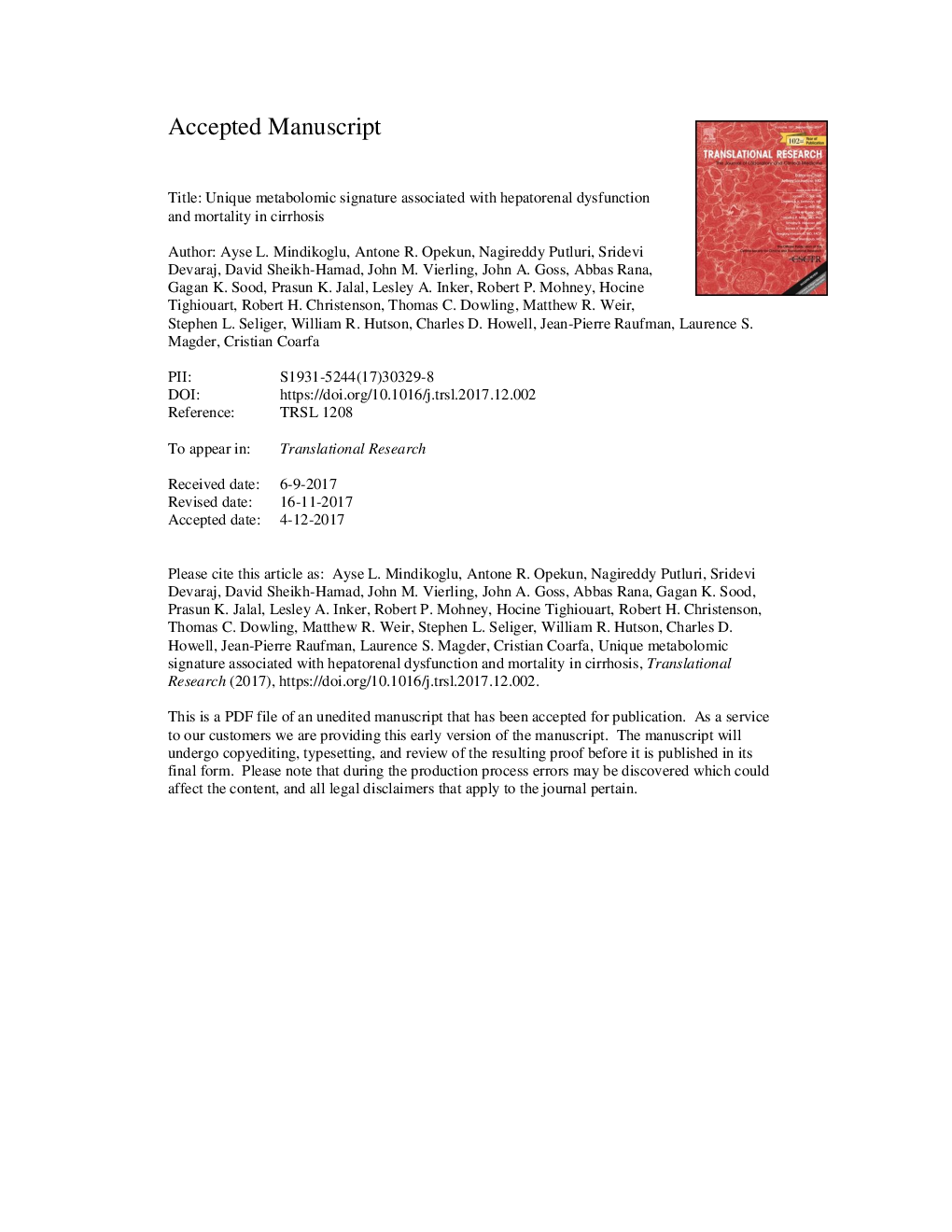| Article ID | Journal | Published Year | Pages | File Type |
|---|---|---|---|---|
| 8768957 | Translational Research | 2018 | 69 Pages |
Abstract
The application of nontargeted metabolomic profiling has recently become a powerful noninvasive tool to discover new clinical biomarkers. This study aimed to identify metabolic pathways that could be exploited for prognostic and therapeutic purposes in hepatorenal dysfunction in cirrhosis. One hundred three subjects with cirrhosis had glomerular filtration rate (GFR) measured using iothalamate plasma clearance, and were followed until death, transplantation, or the last encounter. Concomitantly, plasma metabolomic profiling was performed using ultrahigh performance liquid chromatography-tandem mass spectrometry to identify preliminary metabolomic biomarker candidates. Among the 1028 metabolites identified, 34 were significantly increased in subjects with high liver and kidney disease severity compared with those with low liver and kidney disease severity. The highest average fold-change (2.39) was for 4-acetamidobutanoate. Metabolite-based enriched pathways were significantly associated with the identified metabolomic signature (P values ranged from 2.07Eâ06 to 0.02919). Ascorbate and aldarate metabolism, methylation, and glucuronidation were among the most significant protein-based enriched pathways associated with this metabolomic signature (P values ranged from 1.09Eâ18 to 7.61Eâ05). Erythronate had the highest association with measured GFR (R-squareâ=â0.571, Pâ<0.0001). Erythronate (Râ=â0.594, Pâ<0.0001) and N6-carbamoylthreonyladenosine (Râ=â0.591, Pâ<0.0001) showed stronger associations with measured GFR compared with creatinine (Râ=â0.588, Pâ<0.0001) even after controlling for age, gender, and race. The 5 most significant metabolites that predicted mortality independent of kidney disease and demographics were S-adenosylhomocysteine (Pâ=â0.0003), glucuronate (Pâ=â0.0006), trans-aconitate (Pâ=â0.0018), 3-ureidopropionate (Pâ=â0.0021), and 3-(4-hydroxyphenyl)lactate (Pâ=â0.0047). A unique metabolomic signature associated with hepatorenal dysfunction in cirrhosis was identified for further investigations that provide potentially important mechanistic insights into cirrhosis-altered metabolism.
Keywords
ESIAminoacylase 1ACY1AKIGFRFDRBHMTsDMAUPLCMS/MSAdenosine TriphosphateATPacute kidney injurygamma-aminobutyric acidbetaine homocysteine methyltransferaseBUNsymmetric dimethylarginineTandem mass spectrometryMELD-Nafalse discovery rateGlomerular filtration rateblood urea nitrogenHILICcreatinineUltrahigh performance liquid chromatographyhydrophilic interaction liquid chromatographyGABAelectrospray ionization
Related Topics
Health Sciences
Medicine and Dentistry
Medicine and Dentistry (General)
Authors
Ayse L. Mindikoglu, Antone R. Opekun, Nagireddy Putluri, Sridevi Devaraj, David Sheikh-Hamad, John M. Vierling, John A. Goss, Abbas Rana, Gagan K. Sood, Prasun K. Jalal, Lesley A. Inker, Robert P. Mohney, Hocine Tighiouart, Robert H. Christenson,
